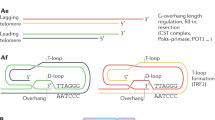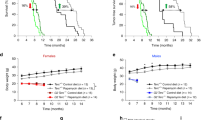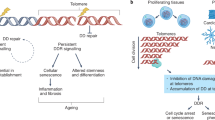Abstract
Ataxia-telangiectasia (A-T) results from the loss of ataxia-telangiectasia mutated (Atm) function and is characterized by accelerated telomere loss, genomic instability, progressive neurological degeneration, premature ageing and increased neoplasia incidence1. Here we evaluate the functional interaction of Atm and telomeres in vivo. We examined the impact of Atm deficiency as a function of progressive telomere attrition at both the cellular and whole-organism level in mice doubly null for Atm and the telomerase RNA component (Terc)2,3,4. These compound mutants showed increased telomere erosion and genomic instability, yet they experienced a substantial elimination of T-cell lymphomas associated with Atm deficiency. A generalized proliferation defect was evident in all cell types and tissues examined, and this defect extended to tissue stem/progenitor cell compartments, thereby providing a basis for progressive multi-organ system compromise, accelerated ageing and premature death. We show that Atm deficiency and telomere dysfunction act together to impair cellular and whole-organism viability, thus supporting the view that aspects of A-T pathophysiology are linked to the functional state of telomeres and its adverse effects on stem/progenitor cell reserves.
This is a preview of subscription content, access via your institution
Access options
Subscribe to this journal
Receive 51 print issues and online access
$199.00 per year
only $3.90 per issue
Buy this article
- Purchase on Springer Link
- Instant access to full article PDF
Prices may be subject to local taxes which are calculated during checkout




Similar content being viewed by others
References
Shiloh, Y. & Kastan, M. B. ATM: genome stability, neuronal development, and cancer cross paths. Adv. Cancer Res. 83, 209–254 (2001)
Lee, H. W. et al. Essential role of mouse telomerase in highly proliferative organs. Nature 392, 569–574 (1998)
Blasco, M. A. et al. Telomere shortening and tumour formation by mouse cells lacking telomerase RNA. Cell 91, 25–34 (1997)
Borghesani, P. R. et al. Abnormal development of Purkinje cells and lymphocytes in Atm mutant mice. Proc. Natl Acad. Sci. USA 97, 3336–3341 (2000)
Kastan, M. B. & Lim, D. S. The many substrates and functions of ATM. Nature Rev. Mol. Cell Biol. 1, 179–186 (2000)
Metcalfe, J. A. et al. Accelerated telomere shortening in ataxia telangiectasia. Nature Genet. 13, 350–353 (1996)
Pandita, T. K. ATM function and telomere stability. Oncogene 21, 611–618 (2002)
Karlseder, J., Broccoli, D., Dai, Y., Hardy, S. & de Lange, T. p53- and ATM-dependent apoptosis induced by telomeres lacking TRF2. Science 283, 1321–1325 (1999)
Barlow, C. et al. Atm-deficient mice: a paradigm of ataxia telangiectasia. Cell 86, 159–171 (1996)
Elson, A. et al. Pleiotropic defects in ataxia-telangiectasia protein-deficient mice. Proc. Natl Acad. Sci. USA 93, 13084–13089 (1996)
Xu, Y. et al. Targeted disruption of ATM leads to growth retardation, chromosomal fragmentation during meiosis, immune defects, and thymic lymphoma. Genes Dev. 10, 2411–2422 (1996)
Kipling, D. & Cooke, H. J. Hypervariable ultra-long telomeres in mice. Nature 347, 400–402 (1990)
Chin, L. et al. p53 deficiency rescues the adverse effects of telomere loss and cooperates with telomere dysfunction to accelerate carcinogenesis. Cell 97, 527–538 (1999)
Hande, M. P., Samper, E., Lansdorp, P. & Blasco, M. A. Telomere length dynamics and chromosomal instability in cells derived from telomerase null mice. J. Cell Biol. 144, 589–601 (1999)
Vaziri, H. et al. ATM-dependent telomere loss in aging human diploid fibroblasts and DNA damage lead to the post-translational activation of p53 protein involving poly(ADP-ribose) polymerase. EMBO J. 16, 6018–6033 (1997)
Hande, M. P., Balajee, A. S., Tchirkov, A., Wynshaw-Boris, A. & Lansdorp, P. M. Extra-chromosomal telomeric DNA in cells from Atm(-/-) mice and patients with ataxia-telangiectasia. Hum. Mol. Genet. 10, 519–528 (2001)
Booth, C. & Potten, C. S. Gut instincts: thoughts on intestinal epithelial stem cells. J. Clin. Invest. 105, 1493–1499 (2000)
Reynolds, B. A. & Weiss, S. Clonal and population analyses demonstrate that an EGF-responsive mammalian embryonic CNS precursor is a stem cell. Dev. Biol. 175, 1–13 (1996)
Ahmed, S., Reynolds, B. A. & Weiss, S. BDNF enhances the differentiation but not the survival of CNS stem cell-derived neuronal precursors. J. Neurosci. 15, 5765–5778 (1995)
Altman, J. & Bayor, S. A. in Development of the Cerebellar System in Relations to its Evolution, Structure and Functions 727–750 (CRC, London, 1997)
Eilam, R. et al. Selective loss of dopaminergic nigro-striatal neurons in brains of Atm- deficient mice. Proc. Natl Acad. Sci. USA 95, 12653–12656 (1998)
Spector, B. D., Filipovich, A. H., Perry, G. S. & Kersey, J. H. in Ataxia-telangiectasia—A Cellular and Molecular Link Between Cancer, Neuropathology and Immune Deficiency (eds Bridges, B. A. & Harnden, D. G.) 103–138 (Wiley, New York, 1982)
Rudolph, K. L. et al. Longevity, stress response, and cancer in aging telomerase-deficient mice. Cell 96, 701–712 (1999)
Artandi, S. E. et al. Telomere dysfunction promotes non-reciprocal translocations and epithelial cancers in mice. Nature 406, 641–645 (2000)
Tyner, S. D. et al. p53 mutant mice that display early ageing-associated phenotypes. Nature 415, 45–53 (2002)
Greenberg, R. A. et al. Short dysfunctional telomeres impair tumorigenesis in the INK4a(delta2/3) cancer-prone mouse. Cell 97, 515–525 (1999)
Smogorzewska, A. & de Lange, T. Different telomere damage signaling pathways in human and mouse cells. EMBO J. 21, 4338–4348 (2002)
Frank, K. M. et al. DNA ligase IV deficiency in mice leads to defective neurogenesis and embryonic lethality via the p53 pathway. Mol. Cell 5, 993–1002 (2000)
Sekiguchi, J. et al. Genetic interactions between ATM and the nonhomologous end-joining factors in genomic stability and development. Proc. Natl Acad. Sci. USA 98, 3243–3248 (2001)
Wong, K. K. et al. Telomere dysfunction impairs DNA repair and enhances sensitivity to ionizing radiation. Nature Genet. 26, 85–88 (2000)
Acknowledgements
We thank D. Castrillon and M. Bosenberg for advice on histo-pathological analyses, and S. Weiler, D. Castrillon, N. Sharpless, N. Bardeesy, C. Khoo and S. Chang for critical reading of the manuscript. K.-K.W. is a Howard Hughes Physician Postdoctoral Fellow. R.S.M. is supported by a Damon Runyon Cancer Research Fund Fellowship. R.M.B. and D.R.C. are both NIH Mentored Clinician Scientists awardees. F.W.A. is supported by the Howard Hughes Medical Institute. This work was supported by grants from the NIH and ACS to R.A.D. R.A.D. is an American Cancer Society Research Professor and a Steven and Michele Kirsch Investigator.
Author information
Authors and Affiliations
Corresponding author
Ethics declarations
Competing interests
The authors declare that they have no competing financial interests.
Supplementary information
41586_2003_BFnature01385_MOESM3_ESM.jpg
Supplementary figure 2. Representative telomere-FISH metaphases spreads from G4 mTerc-/- Atm+/+ and G4 mTerc-/- Atm-/- primary bone marrow culture and representative H&E stains of the bone marrow from the respective mice (JPG 67 kb)
Rights and permissions
About this article
Cite this article
Wong, KK., Maser, R., Bachoo, R. et al. Telomere dysfunction and Atm deficiency compromises organ homeostasis and accelerates ageing. Nature 421, 643–648 (2003). https://doi.org/10.1038/nature01385
Received:
Accepted:
Published:
Issue Date:
DOI: https://doi.org/10.1038/nature01385
This article is cited by
-
Petri nets and ODEs as complementary methods for comprehensive analysis on an example of the ATM–p53–NF-\(\kappa\)B signaling pathways
Scientific Reports (2022)
-
Telomerase reverse transcriptase preserves neuron survival and cognition in Alzheimer’s disease models
Nature Aging (2021)
-
Microcephalin 1/BRIT1-TRF2 interaction promotes telomere replication and repair, linking telomere dysfunction to primary microcephaly
Nature Communications (2020)
-
DNA damage in aging, the stem cell perspective
Human Genetics (2020)
-
Telomeres and telomerase: three decades of progress
Nature Reviews Genetics (2019)
Comments
By submitting a comment you agree to abide by our Terms and Community Guidelines. If you find something abusive or that does not comply with our terms or guidelines please flag it as inappropriate.



